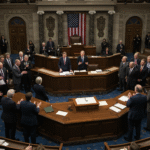H-1B Visa Overhaul: Trump Proposes $100K Fee
The H-1B visa program has been a focal point of immigration policy debates in the United States for years. This non-immigrant visa allows U.S. companies to employ foreign workers in specialty occupations that require theoretical or technical expertise. With the recent proposal announced by former President Donald Trump to impose a hefty $100,000 fee on H-1B visas, the discourse surrounding the program has intensified substantially. This move aims to reconsider the H-1B visa allocation system, prioritizing American workers, while potentially reshaping the landscape of skilled labor in the U.S.
Rationale Behind the $100K Fee Proposal
The proposition of charging a $100,000 fee for H-1B visas stems from a broader objective to revamp the current immigration framework and curb what proponents term “visa abuse.” Trump argues that many H-1B visa holders replace American workers and that increased fees would generate substantial funding for workforce development initiatives aimed at training American workers. This fee would act as a financial barrier intended to slow down the influx of foreign workers, thereby prioritizing job opportunities for citizens.
Impact on Employers and American Workers
If implemented, this fee could have a significant impact on employers, particularly in sectors like technology, healthcare, and engineering that heavily rely on skilled foreign professionals. Companies may face increased operational costs, which could lead to several strategic decisions such as:
Reduction in Hiring: Employers might opt to cut back on hiring foreign workers due to the financial burden posed by the new fee.
Increased Wages: To justify the added costs of the visa application, companies may raise salaries for H-1B employees, which could indirectly encourage higher wage standards across certain sectors.
Transition to Alternative Staffing Models: Companies could shift towards outsourcing jobs or re-evaluating their staffing models to reduce dependency on H-1B workers, potentially leading to job creation abroad rather than in the U.S.
- Investment in Domestic Workforce: Many employers might choose to invest in upskilling and training their current workforce to decrease reliance on foreign talent.
Legal and Logistical Considerations
The proposed overhaul raises several vital legal and logistical questions. Implementing such a fee would require legislative approval, and navigating the complexities of existing immigration laws could be a formidable challenge. It is essential to consider how:
Congressional Support: The proposal will necessitate backing from Congress, which includes bipartisan considerations that could impact its feasibility.
Legal Challenges: The introduction of the fee could face judicial scrutiny, with potential lawsuits asserting that the new fee may be unconstitutional or contradictory to existing immigration laws.
- Visa Application Process: A more costly application process may lead to reduced application rates, lengthier processing times, and increased scrutiny of applicants, creating an even more complex immigration bureaucracy.
Reactions from Various Stakeholders
The announcement of the proposed fee elicited varied responses from stakeholders across the spectrum.
Tech Industry Leaders: Many leaders from Silicon Valley have opposed the measure, emphasizing the crucial role of H-1B visa holders in fostering innovation and economic growth. They argue that higher costs could stifle growth and drive companies to relocate overseas where labor laws may be less stringent.
Labor Union Advocacy: On the other side, labor unions and advocacy groups that support American workers often view the proposal as a step towards safeguarding jobs and ensuring that U.S. citizens are afforded priority in job placements.
- Immigration Advocates: Organizations that work towards immigrant rights see this fee as a punitive measure that would hamper international talent’s ability to make contributions to the U.S. economy, emphasizing the potential for a brain drain in critical sectors.
The Future of the H-1B Visa Program
The potential implementation of a $100,000 fee could significantly alter the trajectory of the H-1B visa program, forcing a reevaluation of current immigration policies. The long-term effects on U.S. innovation, economic competitiveness, and workforce dynamics remain to be seen. As debates continue, stakeholders are eager to understand the complexities that lie ahead and how they can adapt to a changing landscape of labor immigration.
Considerations for Prospective H-1B Applicants
Individuals considering applying for an H-1B visa should remain vigilant and informed about the ongoing discussions surrounding the proposed fee. Planning ahead will be crucial as prospective applicants evaluate the financial implications:
Financial Readiness: Applicants should assess their financial situation, understanding that the new fee may require substantial preparation.
Timing for Applications: Remaining informed about changes to the application timeline can guide applicants deciding when to submit their paperwork.
Alternative Visa Options: For some, exploring alternative visa options that might be less impacted by proposed fees, such as L-1 or O-1 visas, may be prudent.
- Consultation with Legal Experts: Seeking advice from immigration attorneys may help prospective applicants navigate the changing landscape and make informed decisions.
Through ongoing dialogue surrounding the H-1B visa program overhaul, stakeholders can better understand the implications of such policies on employment, innovation, and the economy. The introduction of a $100,000 fee is just one aspect of a much larger conversation about immigration in the United States. Continued engagement from affected parties will be critical in shaping a balanced and inclusive framework that meets the needs of the nation while respecting the contributions of foreign talent.




